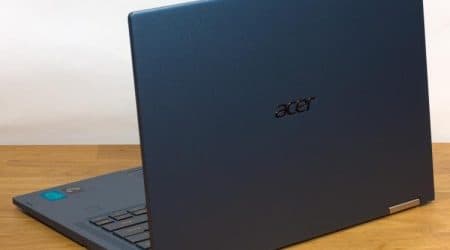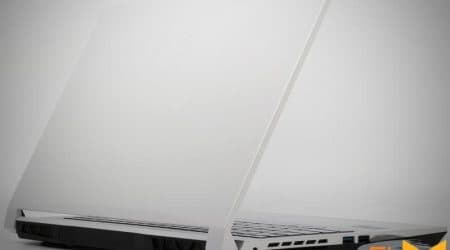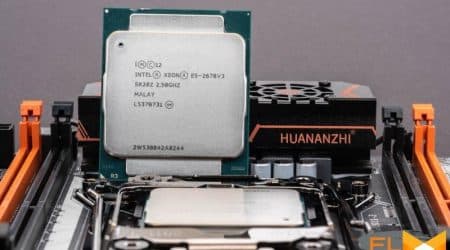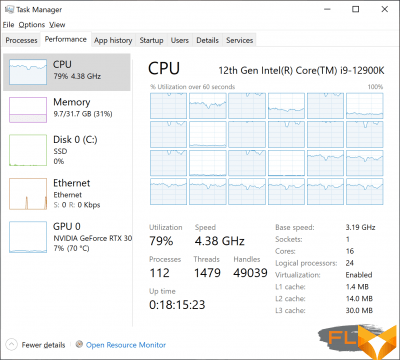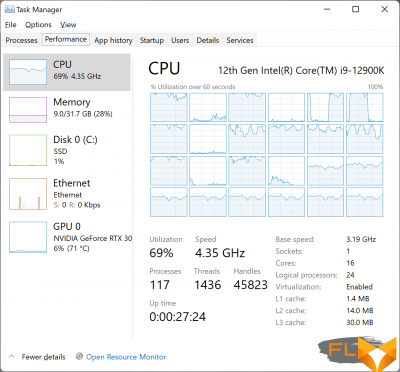


The emergence of the Alder Lake family shook up the entire processor world, which was starving for real competition. The new chips have become better than their predecessors in all respects: they switched to a modern process technology, received noticeable microarchitectural improvements, increased the number of computing cores, and even received improvements related to heat dissipation. But that’s not all. Along with the doubling of the number of compute cores and the leap in performance, Alder Lake brought with it a huge number of new features, which we will have to deal with in detail for a long time. Computing cores of two types and a hybrid structure, support for DDR5 and PCIe 5.0 – these are just the first lines in the list of innovations, for each item of which you need to conduct a separate study. And we will certainly do such studies, however, I would like to start studying the nuances of using the new Intel platform from a slightly different side – not hardware, but software.
Initial testing of the senior representative in the Alder Lake family, the Core i9-12900K processor, was carried out by us in the new Windows 11 operating system. At first glance, this is a logical choice – many users with an update to the hardware platform will certainly want to refresh the software environment: Windows 11, like Alder Lake is one of the hot new releases this fall. In addition, Intel is directly pushing the use of the new operating system, talking about special optimizations in the scheduler. According to the company’s rhetoric, one can even assume that Windows 11 is almost a necessary condition for using Alder Lake, since only this operating system promises support for Thread Director technology, which guarantees the correct distribution of threads across different types of processor cores.
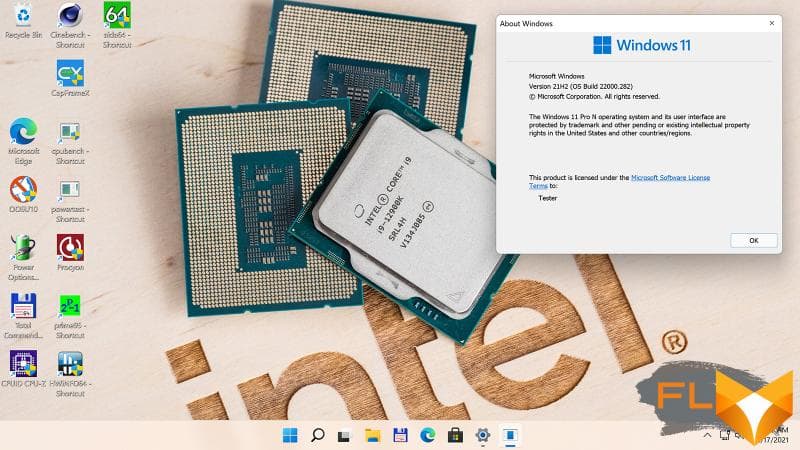
However, there is another position. According to Steam statistics, the Windows 11 operating system is currently used in less than 2% of gaming systems, while the majority of gamers prefer Windows 10 – its share is just under 90%. That is, the transition to a new OS is just beginning, and its speed so far not only does not allow making any predictions about its mass adoption, but also gives firm confidence that Alder Lake-based computers in the real world will run Windows 10 more often.
Therefore, it would be wrong to limit ourselves to testing the Core i9-12900K exclusively in Windows 11, and testing its performance should be repeated in Windows 10. Moreover, the test results in this case will certainly be different. And this applies not only to Alder Lake, with the hybrid features of which the Windows 10 scheduler is much less familiar than the Windows 11 scheduler. Obviously, AMD processors do not work in different OS versions at all in the same way, especially since Ryzen’s relationship with Windows 11 did not work out with the very beginning. You don’t have to look far for examples. Over the past couple of months since the release of Windows 11, AMD and Microsoft engineers have had to hastily fix at least two troubles with Ryzen – slow L3 cache and incorrect scheduler selection of the preferred core for single-threaded workloads. Naturally, there is no guarantee that these problems were the only ones, and this can also cause differences in relative CPU performance in Windows 11.
However, the central issue, which will be given the most attention in this article, still concerns the compatibility of Alder Lake and Windows 10. From what we learned about Thread Director technology immediately before the announcement of the 12th generation Core processors, it followed that they work the new OS is completely different from the old one, and because of this, in Windows 10 you can expect all sorts of overlays both with performance and with the inoperability of various programs (primarily games). Therefore, the main storyline of the further story will be a practical comparison of the Core i9-12900K in Windows 10 and Windows 11.
⇡#Thread Director again
The fundamental advantage of Windows 11 over Windows 10 in terms of Alder Lake processors is that the new OS is familiar with Thread Director technology, and its scheduler uses the capabilities of this technology to distribute the load across processor cores, including heterogeneous ones. In simple terms, in Windows 10, the work of the scheduler with different types of cores is based solely on their performance data, while in Windows 11 everything is more tricky. In it, the scheduler not only distinguishes cores by speed, but also receives feedback from the processor – interactive information about the types of executable code and information about the state, current temperatures and power consumption of the cores.
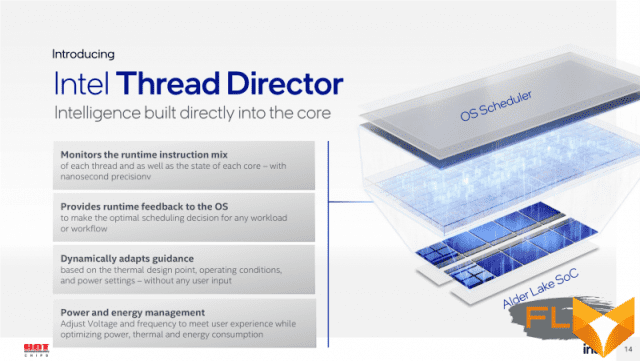
At a low level, the Thread Director is a microcontroller built into Alder Lake that collects data on the functioning of processor cores with nanosecond discreteness, analyzes them, and transmits them to the operating system scheduler with millisecond discreteness. The telemetry that the microcontroller deals with is the thermal state and consumption of each of the cores, plus their load indicators, including information about the types of instructions being executed. This set of collected data ultimately allows you to make informed decisions about the advisability of moving certain processes from productive cores (P-cores) to energy-efficient cores (E-cores) and vice versa.
In the process of joint work, Thread Director and the Windows 11 scheduler divide all executable processes into three basic classes: background, that is, those whose execution speed does not depend on processor performance; regular foreground processes; and resource-intensive processes that involve certain sets of AVX instructions. The general logic of the scheduler in Windows 11 is such that background processes or processes that spend most of their time waiting for data to arrive are sent to E-cores, and those processes for which performance is really important are sent to P-cores. At the same time, processes using AVX instructions are considered to have higher priority, and as the processor runs out of free P-cores, less demanding threads are forced out to E-cores.
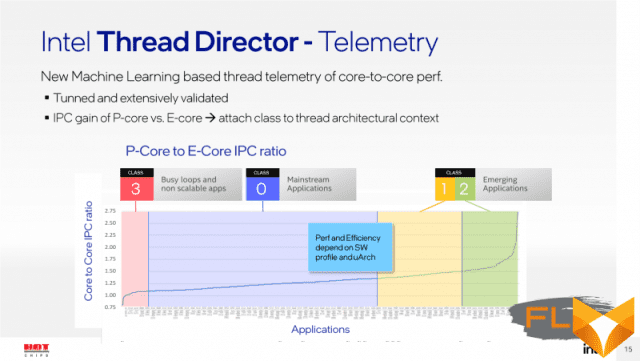
Such a division of threads into classes is not available to the Windows 10 scheduler, it does not know anything about their specifics and simply sends threads that take more CPU time to more productive cores. If we talk about the performance of resource-intensive multi-threaded applications, then it will obviously be the same in Windows 10 and Windows 11. However, in complex workload scenarios, the more sensitive scheduler strategy implemented in Windows 11 can have a positive effect on the speed of tasks. But the main advantage of Thread Director lies in the area of energy efficiency. The task of the Windows 11 scheduler is not only to get the maximum performance from the processor, but also to do it with minimal energy costs, as much as possible (but without sacrificing performance) by involving the E-core in the work. At the same time, in Windows 10, the issue of energy consumption is not considered at all.
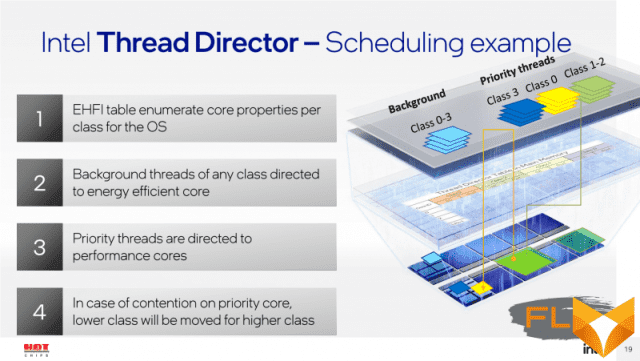
But you need to understand that even in Windows 11, Thread Director technology plays the role of an auxiliary tool. The OS scheduler in managing threads is not required to be guided by the recommendations that the Thread Director issues. For example, they may not be taken into account when executable processes have different priorities, or when the user has an application deployed on the desktop that is not a priority from the point of view of the Thread Director. However, the low-level interaction between hardware and OS that Windows 11 has allows you to use the Alder Lake hybrid architecture in a more advantageous way.
⇡#Alder Lake Power Consumption: Windows 11 vs. Windows 10
So, the Windows 11 scheduler, along with the Thread Director, is fighting for efficiency. In words, all this sounds very logical: knowing what the current requests of executable threads are, the scheduler of the new operating system can send undemanding processes to E-cores, which have a simpler microarchitecture and lower frequencies. And it’s not difficult to check whether this gives any result – just look at the consumption of Alder Lake when performing the same tasks on different operating systems.
For our experiments, we used a Core i9-12900K-based system equipped with 32GB DDR5-4800, on which we took power consumption readings in identical scenarios in Windows 10 and Windows 11. The first test was rendering in Cinebench R23. This task is characterized by the fact that all available cores are loaded during rendering, which means that Thread Director is unlikely to help here: the scheduler simply has to allocate 24 threads created by the application to the 24 cores available to the processor (including virtual ones).
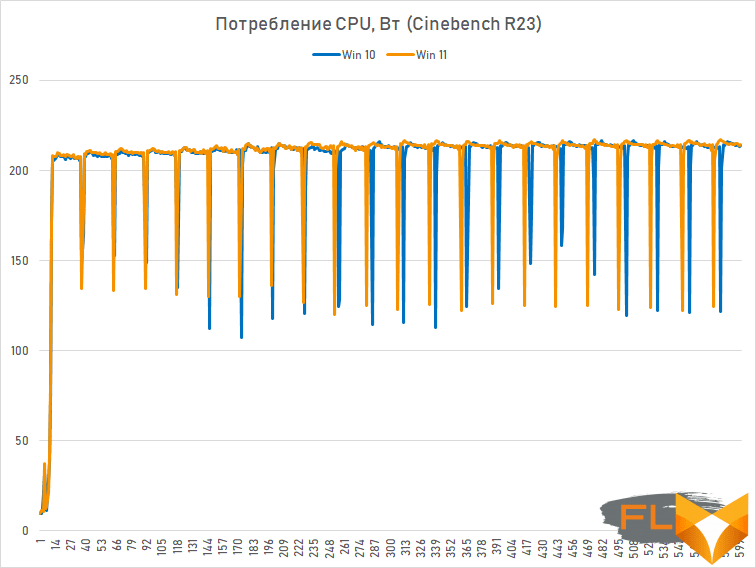
This is exactly what we see on the consumption graph. Core i9-12900K when rendering in Windows 10 and Windows 11 shows almost identical consumption – here Thread Director does not give any gain.
However, this pattern is not always observed. There are many cases when there is a significant difference in the operation of Alder Lake under Windows 10 and under Windows 11. The most common is games. Modern gaming applications try to parallelize the load, and many of them create a significant number of threads. However, the specificity of these streams is that they are mostly unequal. One or two threads usually play the role of leaders, while the rest are of an auxiliary nature, performing secondary calculations as necessary or waiting for the player’s reaction or some other events. And this is the perfect ground for the Thread Director and Windows 11 scheduler to unfold in full force.
For example, we took the game Horizon Zero Dawn, which actively uses multithreading and easily loads all 16 virtual cores on eight-core processors. And as testing has shown, the consumption of the Core i9-12900K in different operating systems really differs.

The average consumption of the Core i9-12900K during the test pass in Horizon Zero Dawn was 103 W in Windows 11 and 109 W in Windows 10. That is, the Thread Director technology, due to the careful arrangement of threads among the cores, can achieve approximately 6% energy savings.
But an even more interesting picture can be seen if you look into the task manager. In Windows 11, during the game, the processor load is also lower, and by a rather significant amount of 10%.
| Windows 10 | Windows 11 |
Here it is appropriate to recall that the “processor load” metric shown in modern operating systems is not really such. In fact, the OS does not display the relative time spent by the processor on work, but a different value – its “non-idle time”, that is, the relative amount of time that the processor spent outside the special Idle thread created by the scheduler. And this means that idle processor work, when running threads do not terminate, but are idle, waiting for some data to be received, is treated in the task manager readings as loading, and not as idle. Therefore, lower CPU usage in Windows 11 does not mean that it does less work. Simply, by receiving information from the Thread Director about which of the threads actually use the processor resources, and which ones are just waiting for data, the scheduler is able to better pack idle threads on E-cores, freeing up P-cores for real computing load.
For the user, this means that on systems based on Alder Lake processors, the use of Windows 11 will not only achieve better economy, but also generally get a better implementation of multithreading.
Horizon Zero Dawn is far from the only game where the Core i9-12900K shows lower power consumption in Windows 11. A similar situation is observed in a lot of other applications. For example, the following graph shows the consumption of an older Alder Lake in two OS versions in another gaming application – Shadow of the Tomb Raider.
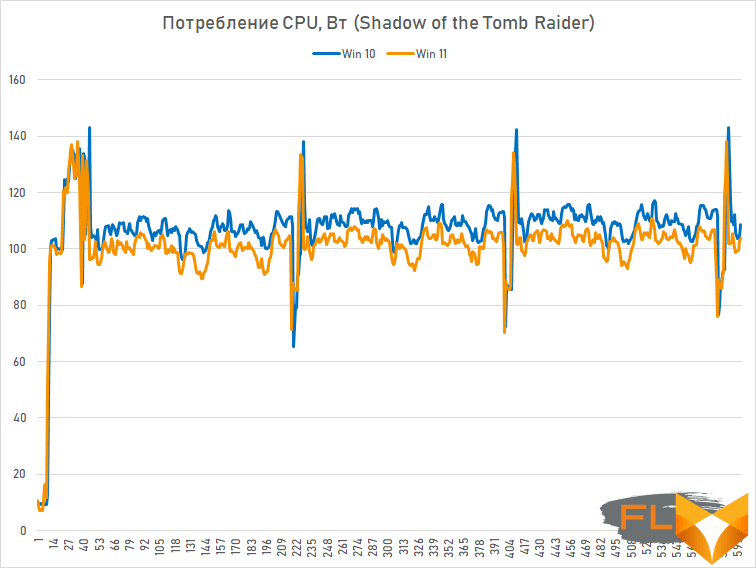
And again, the same thing, only here the difference in average consumption is already about 9 W, that is, using Windows 11 with Thread Director technology reduces processor consumption by almost 10%.
However, the picture when the consumption of Alder Lake in Windows 11 is lower does not take place in one hundred percent of situations. There are also reverse examples, in particular, ordinary office work in applications from the Microsoft Office package. In order to simulate the daily work of a user in Word, Excel, PowerPoint and Outlook, we used the Procyon Office Productivity test script. And in its execution, contrary to expectations, the consumption of the Core i9-12900K-based platform in Windows 11 exceeded the consumption of the same platform in Windows 10 by several watts.
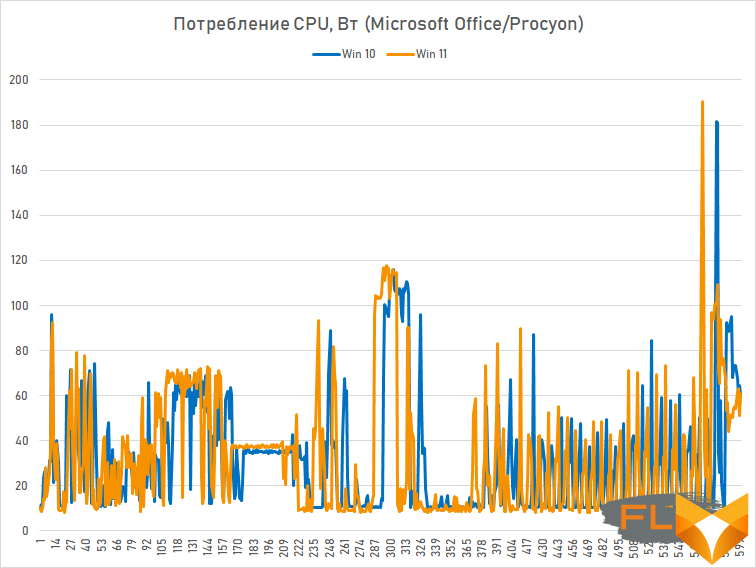
At first glance, this is a very strange result, since office applications are an obvious example of a workload that can run on energy efficient cores, reducing power consumption. In practice, the average consumption of the Core i9-12900K in Windows 11 turns out to be 1-2 W higher than in Windows 10. But there is a simple explanation for this phenomenon: the key suggests a shift in the curves corresponding to consumption in Windows 10 and Windows 11 relative to each other on the right side of the graph. This is because Office applications run faster in Windows 11, which causes their increased power consumption.
In other words, another advantage of Windows 11 pops up here. Due to the fact that this OS is thoroughly familiar with the features of Intel’s hybrid processor architecture, it does not get confused in heterogeneous cores, and some applications demonstrate higher performance in it. In particular, the speed of execution of the Procyon Office Productivity office script in Windows 11 turned out to be about 9% faster than in Windows 10. This means that the performance of the Core i9-12900K in different operating systems really differs, and this issue deserves a separate discussion.
⇡#Windows 11 and Virtualization-based Security (VBS)
But before we jump into the benchmark results, there’s one Windows 11 security setting that directly affects them: Virtualization-based Security (VBS). Alarmist reports have indicated that this option can easily ruin gaming performance, and in some cases it is enabled by default.
The VBS mechanism, or “virtualization-based security”, allows Windows 11 to create a secure memory enclave for mission-critical applications, completely isolated from potentially unsafe code, including from the OS itself along with its vulnerabilities. In addition, another built-in security feature based on VBS, Hypervisor-Enforced Code Integrity (HVCI), prevents unsigned or questionable drivers and software from entering the system memory area. Together, the VBS and HVCI functions are aimed at protecting the OS and sensitive user data from malware, even if it can bypass existing antivirus protection. VBS and HVCI could be activated in Windows 10, but there these features were always initially turned off. With the release of Windows 11, Microsoft has tightened security standards, and now VBS and HVCI will be automatically activated on a number of systems. First of all, this applies to cases when Windows 11 is installed on a computer from scratch. On a clean install, the security settings will most likely be enabled unless virtualization has been disabled via the BIOS. However, at the same time, when upgrading from Windows 10 to Windows 11, if the corresponding options were not enabled in the old OS, then they will remain deactivated in the new OS. If we are talking about buying a ready-made computer, then in this case the decision to activate VBS and HVCI in the settings is made by the manufacturer.
So, by default, Windows 11 users will get two different configuration options depending on the origin of the computer and the type of OS installation. And it is impossible to say which one is “more correct”. Intel recommends keeping VBS and HVCI on Alder Lake processor-based systems as it improves system security. However, in this case, you will have to put up not only with a slight decrease in performance, but also with the inoperability of individual versions of programs, such as pirated games.
Therefore, speaking about the performance of modern systems in Windows 11, you will have to consider two options for settings – both with activated VBS and HVCI functionality, and without it.
You can check whether the VBS mechanism is active on a particular system using the standard MSInfo32.exe (System Information) tool.

VBS is turned on and off by the Memory integrity switch, which is located in the system settings on the Core Isolation page, located in the Privacy & Security/Windows Security/Device Security.
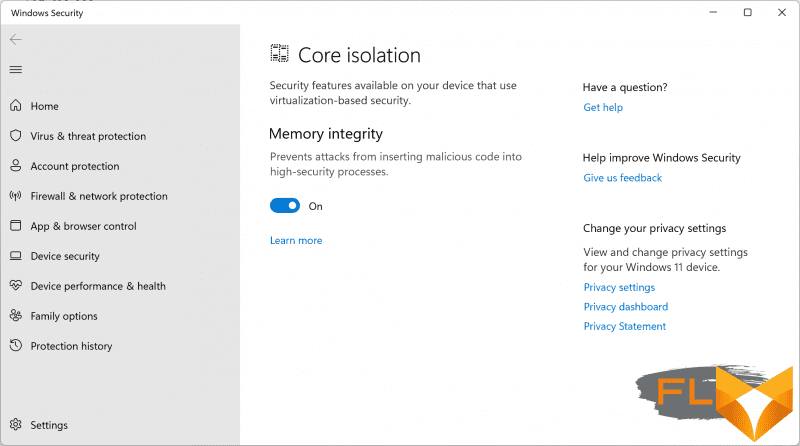
⇡#Description of the test system and testing methodology
The main task of testing was to determine the difference in performance of the Core i9-12900K when running in the old Windows 10 operating system without Thread Director support and in the new Windows 11 with support for this technology. However, to complete the picture, performance measurements were performed not only on the Core i9-12900K-based platform, but also on an alternative system with a Ryzen 9 5950X processor. Thus, along the way, we will be able to answer the question of what the transition to Windows 11 can give users of AMD processors.
- Processors:
- AMD Ryzen 9 5950X (Vermeer, 12 cores + SMT, 3.4-4.9GHz, 64MB L3);
- Intel Core i9-12900K (Alder Lake, 8P+8E-cores + HT, 3.5-5.3/2.4-3.9GHz, 30MB L3).
- CPU cooler: EKWB custom coolant
- Motherboards:
- ASUS ROG Crosshair VIII Hero (Socket AM4, AMD X570);
- ASUS ROG Strix Z690-F Gaming WiFi (LGA1700, Intel Z690).
- Memory:
- 2x16GB DDR4-3600 SDRAM, 16-18-18-38 (Crucial Ballistix RGB BL2K16G36C16U4BL);
- 2 × 16 GB DDR5-4800 SDRAM, 38-38-38-70 (Kingston Fury Beast KF548C38BBK2-32).
- Video Card: NVIDIA GeForce RTX 3090 Founders Edition (GA102, 1395-1695/19500MHz, 24GB GDDR6X 384-bit).
- Disk subsystem: Intel SSD 760p 2TB (SSDPEKKW020T8X1).
- Power supply: Thermaltake Toughpower DPS G RGB 1000W Titanium (80 Plus Titanium, 1000W).
All compared processors were tested with the settings accepted by the board manufacturers by default. This means that for Intel platforms, the TDP/PBP limits indicated in the specifications are ignored, and instead the maximum possible frequencies are used in order to obtain maximum performance. The vast majority of users operate processors in this mode, since enabling heat dissipation and power consumption limits in most cases requires special BIOS settings.
Memory subsystem settings for all systems were performed using XMP profiles.
Used versions of operating systems:
- Microsoft Windows 10 Pro (21H1) Build 19043.1023;
- Microsoft Windows 11 Pro (21H2) Build 22000.282.0 with KB5005635 and KB5006746 installed.
And driver versions:
- AMD Chipset Driver 3.10.08.506;
- Intel Chipset Driver 10.1.18838.8284;
- Intel SerialIO Driver 30.100.2105.7;
- Intel Management Engine Interface 2124.100.0.1096;
- NVIDIA GeForce 496.49 Driver
Description of the tools used to measure computing performance:
Comprehensive benchmarks:
- Futuremark PCMark 10 Professional Edition 2.1.2508 – testing in Essentials scenarios (typical work of the average user: launching applications, surfing the Internet, video conferencing), Productivity (office work with a word processor and spreadsheets), Digital Content Creation (creating a digital content: photo editing, non-linear video editing, rendering and visualization of 3D models).
- 3DMark Professional Edition 2.17.7173 – testing in Time Spy Extreme 1.0 scene.
Applications:
- 7-zip 21.02 – archiving speed testing. The time taken by the archiver to compress a directory with various files with a total volume of 3.1 GB is measured. Uses LZMA2 algorithm and maximum compression ratio.
- Adobe After Effects 2021 18.4.0 – Animation Render Speed Test. The time taken by the system to render a pre-prepared video in 1920 × 1080@30fps resolution is measured.
- Adobe Photoshop 2021 22.4.3 – Graphics performance testing. The average execution time of the Puget Systems Adobe Photoshop CC Benchmark 18.10 test script, which simulates the typical processing of an image taken by a digital camera, is measured.
- Adobe Photoshop Lightroom Classic 10.3 – Performance test for batch processing of a series of RAW images. The test scenario includes post-processing and export to JPEG at a resolution of 1920 × 1080 and a maximum quality of two hundred 16-megapixel RAW images taken with a Fujifilm X-T1 digital camera.
- Adobe Premiere Pro 2021 15.4.0 – performance testing for non-linear video editing. Measures rendering time to YouTube 4K for a project containing HDV 2160p30 footage with various effects applied.
- Blender 2.93.5 – testing the speed of the final rendering in one of the popular free packages for creating three-dimensional graphics. The duration of building the final model pavillon_barcelona_v1.2 from Blender Benchmark is measured.
- Cinebench R23 is the standard benchmark for testing rendering speed in Cinema 4D R23.
- Magix Vegas Pro 19.0 – performance testing for non-linear video editing. Measures rendering time to YouTube 4K for a project containing HDV 2160p30 footage with various effects applied.
- Microsoft Visual Studio 2017 (15.9.40) – Compile time measurement for a large MSVC project – Blender 2.79b professional 3D package.
- Stockfish 14.1 – testing the speed of the popular chess engine. The speed of enumeration of options in the position “1q6/1r2k1p1/4pp1p/1P1b1P2/3Q4/7P/4B1P1/2R3K1 w” is measured.
- SVT-AV1 v0.8.6 – testing the speed of video transcoding to the promising AV1 format. Performance is measured using a raw 1080p@50FPS AVC video file with a bitrate of about 30 Mbps.
- Topaz Video Enhance AI v2.3.0 – performance testing in an AI-based program to improve video detail. The test uses the original video at 640×360 resolution, which is doubled using the Artemis Anti Aliasing v9 model.
- V-Ray 5.00 – Benchmark the performance of a popular rendering system using the standard V-Ray Benchmark Next application.
- VeraCrypt 1.24 – cryptographic performance testing. The benchmark built into the program is used, which uses Kuznyechik-Serpent-Camellia triple encryption.
- x264 r3059 – testing the speed of transcoding video to H.264/AVC format. To evaluate performance, we use the original 2160p@24FPS AVC video file with a bitrate of about 42 Mbps.
- x265 3.5+8 10bpp – testing the speed of video transcoding to H.265/HEVC format. To evaluate performance, we use the original 2160p@24FPS AVC video file with a bitrate of about 42 Mbps.
Games:
- Borderlands 3. Resolution 1920 × 1080: Graphics API = DirectX 12, Overall Quality = Badass.
- Chernobylite. Resolution 1920 × 1080: Graphics Quality = Ultra.
- Civilization VI: Gathering Storm. Resolution 1920×1080: DirectX 12, MSAA=4x, Performance Impact=Ultra, Memory Impact=Ultra.
- Cyberpunk 2077. 1920 × 1080 resolution: Quick Preset = Ray Tracing – Ultra.
- Far Cry 6. 1920 × 1080 resolution: Graphics Quality = Ultra, HD Textures = On, Anti-Aliasing = TAA.
- Hitman 3. 1920 × 1080 resolution: Super Sampling = 1.0, Level of Detail = Ultra, Texture Quality = High, Texture Filter = Anisotropic 16x, SSAO = Ultra, Shadow Quality = Ultra, Mirrors Reflection Quality = High, SSR Quality = High, Variable Rate Shading = Quality.
- Horizon Zero Dawn. Resolution 1920 × 1080: Preset = Ultimate Quality.
- Metro Exodus Enhanced. 1920×1080 resolution: Shading Quality = Ultra, Ray Tracing == Normal, Reflection = Raytraced, Variable Rate Shading = 4x, Hairworks = Off, Advanced PhysX = Off, Tesselation = Off.
- Shadow of the Tomb Raider. Resolution 1920 × 1080: DirectX12, Preset = Highest, Anti-Aliasing = TAA.
- A Total War Saga: Troy. Resolution 1920 × 1080: DirectX 12, Quality = Ultra, Unit Size = Extreme.
- Watch Dogs Legion. Resolution 1920 × 1080: DirectX 12, Quality = Ultra, RTX = Off, DLSS = Off.
In all gaming tests, the results are the average number of frames per second, as well as the 0.01-quantile (first percentile) for FPS values. The use of the 0.01-quantile instead of the minimum FPS is due to the desire to clean up the results from random bursts of performance that were provoked by reasons not directly related to the operation of the main components of the platform.
⇡#Performance in complex benchmarks
The PCMark 10 test reproduces typical user activity in daily work with office applications, and it is these applications that are most prone to problems with the correct execution on the Alder Lake processor with a hybrid architecture. Windows 10 obviously gets lost in choosing the right cores to run threads on, and this results in significant performance degradation. This is most evident in the Digital Content Creation scenario – here the Core i9-12900K results in Windows 10 and Windows 11 differ by more than twice. But this is a clear kurtosis, because in other scenarios such a difference in results is not observed. However, potential owners of Alder Lake should be aware that in certain situations, the use of an old OS can affect the performance of the platform so significantly.
Enabling VBS can also affect the performance of the Core i9-12900K, according to PCMark 10 readings. But enabling virtualization-based security features results in only a four percent drop in performance, which can hardly be called a significant loss.
Separately, we note that the Ryzen 9 5950X processor, which takes part in the tests along with the older Alder Lake, reacts even weaker to enabling VBS in Windows 11. However, in general, when it is transferred to a new version of the OS, the performance indicators deteriorate slightly, that is, from the point of view of PCMark 10, the flagship AMD processor is preferable to use in Windows 10, despite the fact that all Ryzen and Windows 11 incompatibility issues are considered already eliminated.
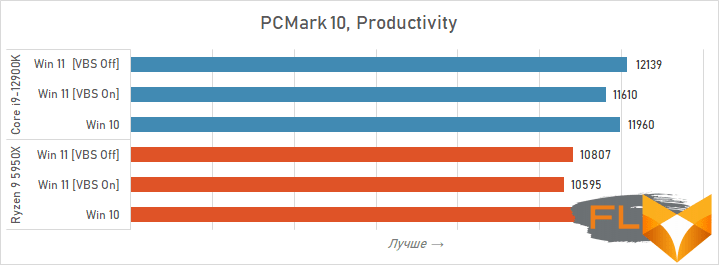
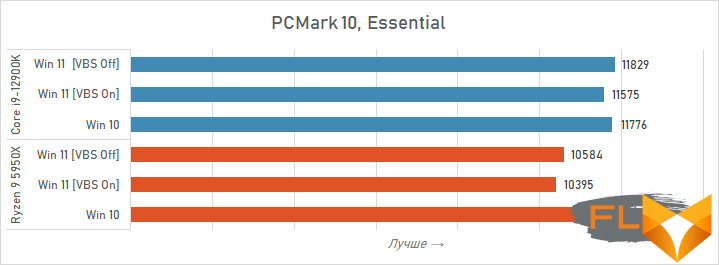
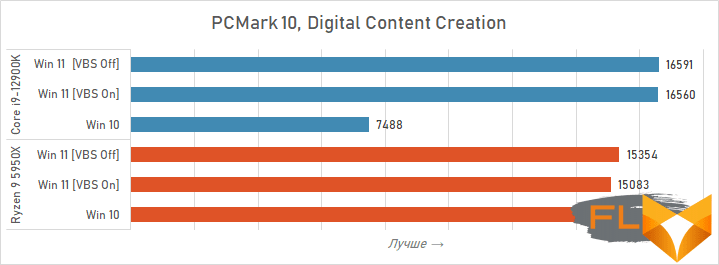
The 3DMark Time Spy Extreme near-game test does not reveal clear differences in processor performance in Windows 11 and Windows 10. Also, turning on VBS has little effect on the result.
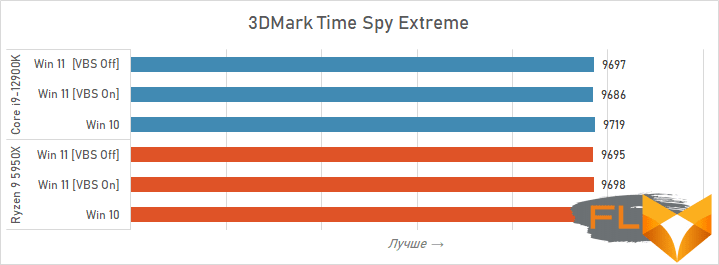

⇡#Performance in Applications
In general, the performance of the Core i9-12900K in resource-intensive applications does not depend so much on the version of the selected operating system. In most cases, Windows 11, which is familiar with the design of this processor and supports Thread Director technology, can provide a percentage advantage. In some tasks, for example, when processing video in Topaz Video Enhance AI and Adobe After Effects, the new OS allows you to get an advantage of 5-6%. And only in a single case – when transcoding video with the x264 codec – does Windows 11 provide fundamentally better performance against the background of Windows 10. In other words, differences in the speed of performing “heavy” tasks when using different versions of the OS are almost always insignificant. But nevertheless, situations where Windows 10 seriously spoils the performance of Alder Lake still occur.
As for the platform on the Ryzen 9 5950X processor, the picture is somewhat different with it. In terms of application speed, Windows 10 is better suited for it, although the difference, frankly, is subtle. The gap in results averages 1.5%, and the maximum advantage that Windows 10 can give reaches 6% – it is observed when transcoding video with the x264 codec and when increasing video resolution in Topaz Video Enhance AI.
At the same time, both platforms, both AMD and Intel, tolerate VBS activation quite calmly. If there is a drop in performance, then it will not be easy to notice it – usually it is a fraction of a percent. Only Adobe Photoshop can be called an exception, but even in it, the performance when VBS is turned on decreases by a rather insignificant amount – 6.5%.
Rendering:
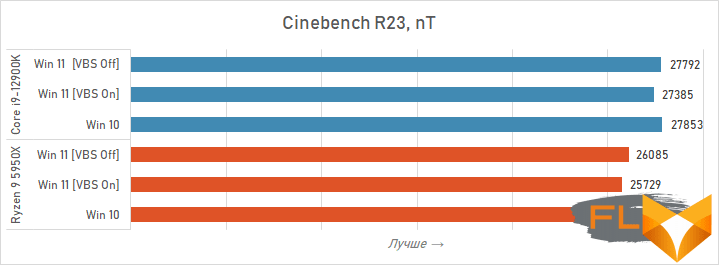
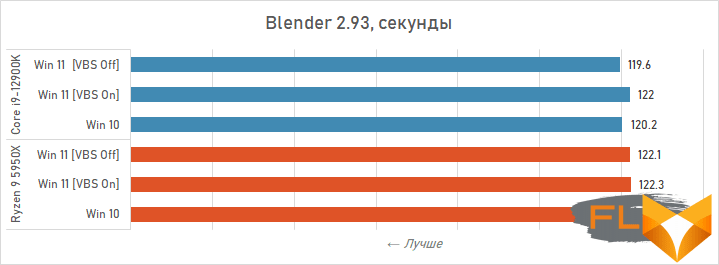
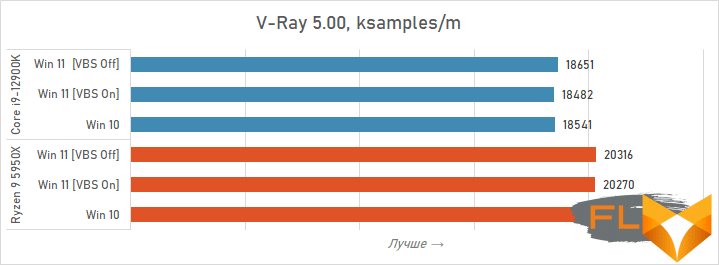
Photo processing:
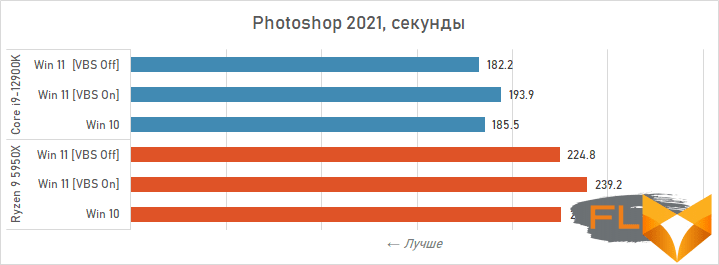
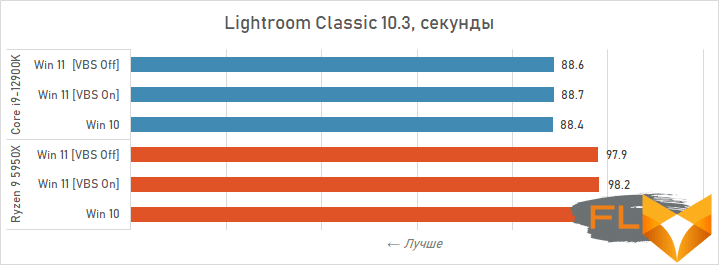
Video work:
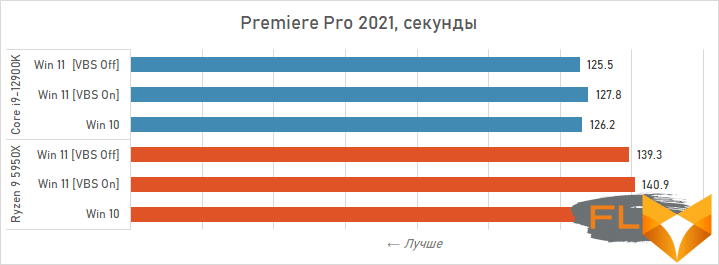
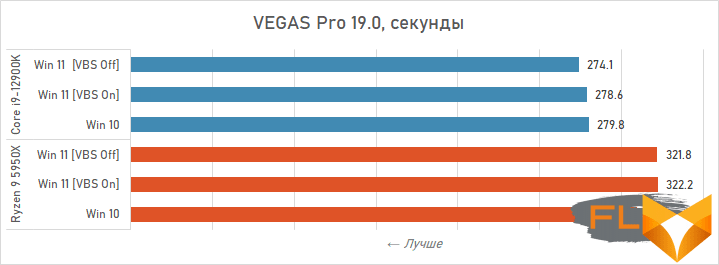
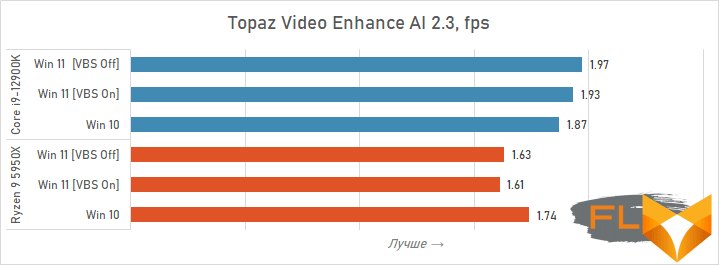

Video transcoding:
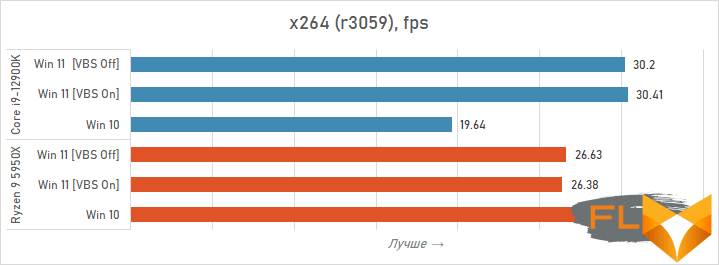


Compilation:
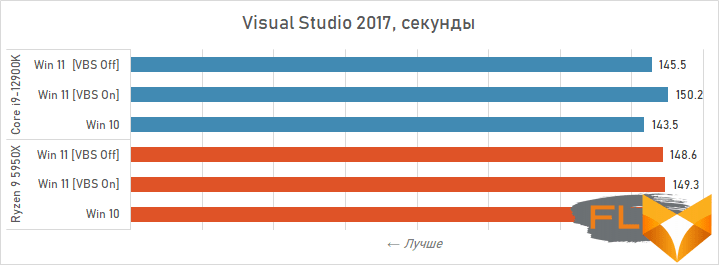
Archiving:
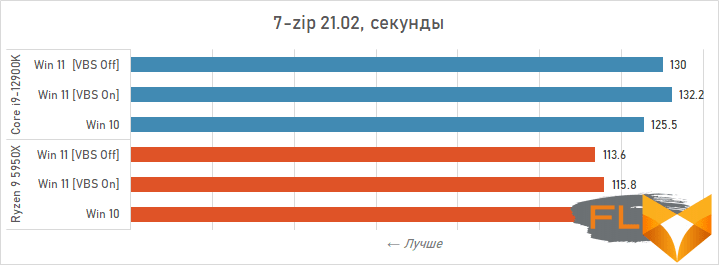
Chess:
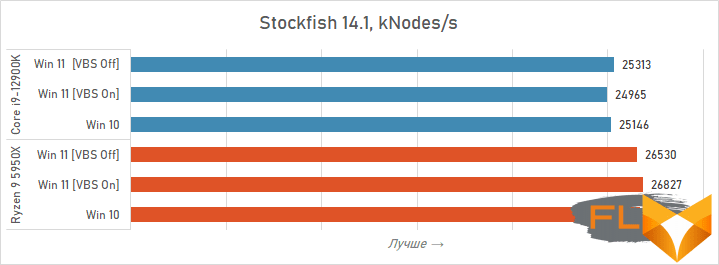
Encryption:
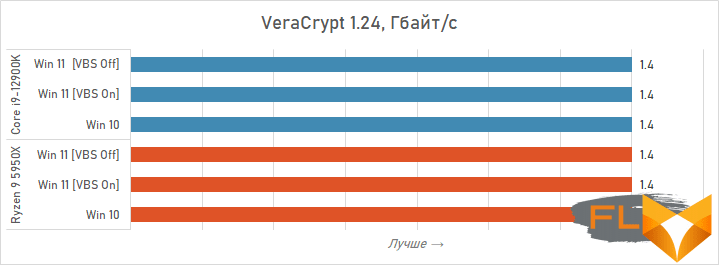
⇡#Game performance
Here the difference between operating systems is more pronounced. Games have shown the advantage of Windows 11 for Alder Lake when measuring power consumption, and a similar advantage of the new OS looms when comparing frame rates at Full HD resolution when using powerful graphics. The Core i9-12900K-based configuration shows about 4% better gaming performance in Windows 11, but in some cases, such as Chernobylite or Hitman 3, the new OS adds up to 10% more frame rates. Obviously, this is entirely the merit of Thread Director technology.
Confidence in this is strengthened by the results of the Ryzen 9 5950X, which receives almost no increase from Windows 11. The AMD platform in the new version of the OS is the fastest on average by 1.5% with a maximum margin of 4% from the results obtained in Windows 10.
Thus, when comparing gaming performance in Windows 10, the flagship AMD and Intel processors show closer results than in Windows 11. And while the Core i9-12900K lead over the Ryzen 9 5950X remains, instead of a 9 percent advantage in the new OS in Windows 10, it can boast of winning with an average FPS margin of only 5%.
In addition to the above, it is worth adding that the inclusion of VBS does not lead to any catastrophic consequences for gaming performance. For both platforms, the drop in average frame rate is about 2%, which can hardly be a strong argument in favor of disabling this option in Windows 11, at least on systems with modern and fast processors.
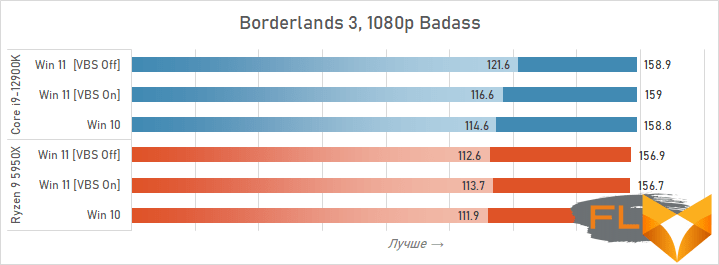

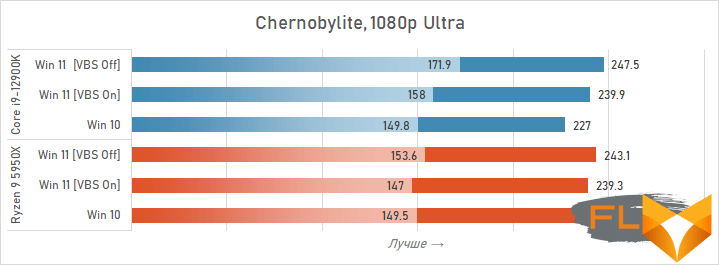
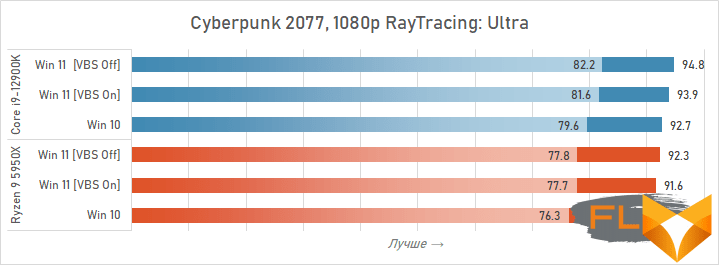

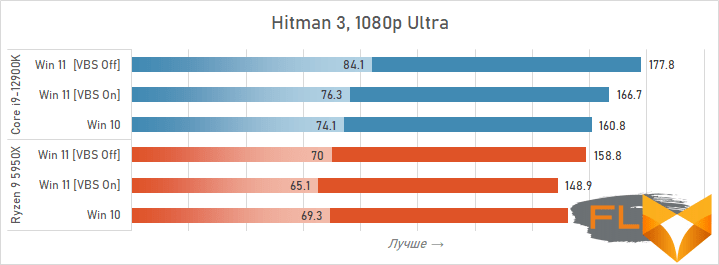
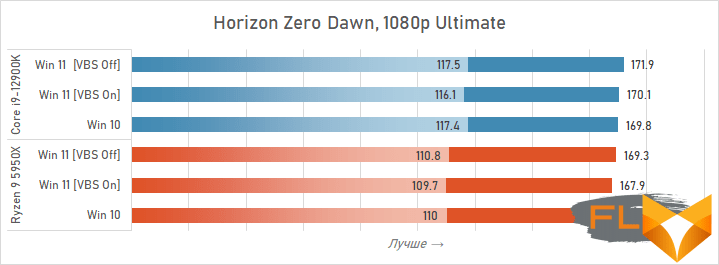
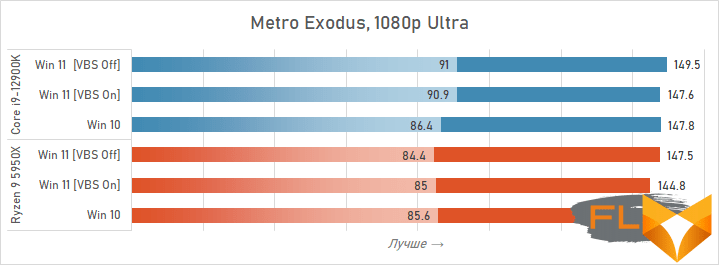
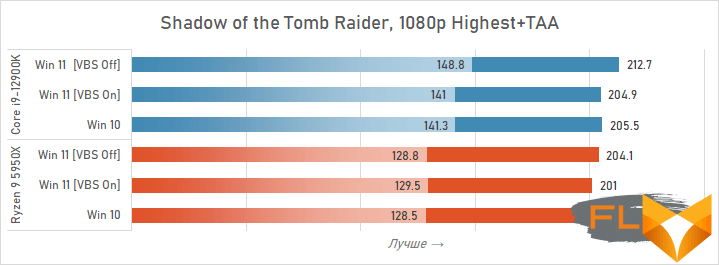
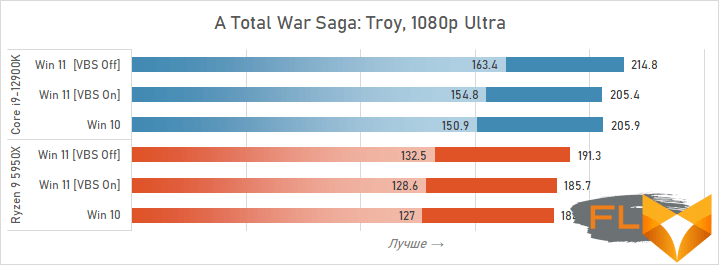
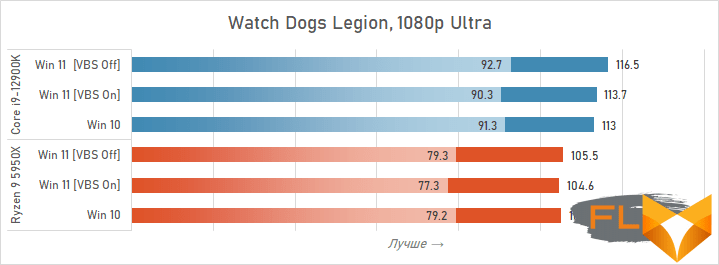
⇡#Compatibility issues
Speaking about performance in games, one cannot ignore another aspect that is associated with the operation of gaming systems built on processors from the Alder Lake family – compatibility. The fact is that some games turned out to be inoperable on processors with a hybrid architecture. Or rather, not the games themselves, but the Denuvo DRM protection built into them. Intel’s website lists 51 games that won’t run on the latest processors because Denuvo treats two types of cores inside the same Alder Lake as two different PCs. Moreover, more frequent problems occur precisely in Windows 10, while in Windows 11 the list of problematic games is more than half as long and contains only 22 items.
Thus, for another reason, it is better to use Windows 11 in gaming systems – in this operating system, incompatibility of gaming software is less common. And we can confirm from our own experience that this is indeed the case. Many DRM-protected games often do not launch on the first try on Windows 10, even if they don’t appear on Intel’s list. Games from the list do not work at all. For example, for this reason, we had to abandon testing in Assassin’s Creed: Valhalla.
Of course, all such incompatibilities will be fixed as new patches are released. But while they are able to deliver the players a lot of trouble. However, Intel has come up with a workaround for the problem – a special Legacy Game mode, in which E-cores can be turned off for the duration of the launch of capricious games. Motherboard manufacturers should soon implement Legacy Game mode at the BIOS level: ASUS and MSI are known to be already working on implementing this feature. So very soon users of systems based on Alder Lake will be able to enable and disable E-cores directly from the OS. The Scroll Lock key on the keyboard will be responsible for switching, and changing the status of energy-efficient cores will not require a system reboot.
However, at the moment Legacy Game mode is not implemented, and the games have not received the necessary updates. Therefore, compatibility can be achieved in only one way – by completely disabling E-cores. The corresponding option is present in the BIOS of all LGA1700 motherboards, you need to look for it among the basic processor settings.
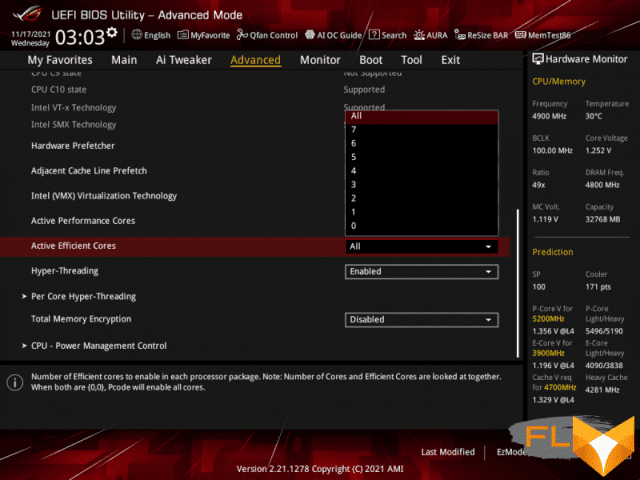
However, be aware that when E-cores are disabled, Alder Lake processors lose both performance and power efficiency, so this method is a last resort.
⇡#Conclusions
The announcement of Alder Lake processors was framed in such a way that the need to use them with Windows 11 seemed both mandatory and self-evident. Intel has been persistent in talking about the benefits of Thread Director technology, and this story was based on the thesis that the hybrid architecture of the 12th generation Core is able to fully reveal itself only with the new OS. The conducted testing confirmed that Intel was not cunning. In Windows 11, Alder Lake processors really do perform better in every way. Performance is higher, power consumption is lower, and there are fewer compatibility issues with older games.
But this does not mean at all that a computer with Alder Lake must have Windows 11 installed. In fact, these processors also work well with Windows 10: it is impossible to say that there are any noticeable problems in any of the above areas. The load balancing mechanisms available in the old version of OC cope with the tasks assigned to them without Thread Director, thanks to which the Core i9-12900K remains a faster processor compared to the Ryzen 9 5950X and in Windows 10.
The difference in the performance of the Core i9-12900K in Windows 10 and Windows 11, according to the test results, is a few percent. There are extreme situations when the scheduler of the old OS categorically fails to properly dispatch threads, but they are rather rare exceptions.
The power advantage Windows 11 brings to Alder Lake is also quite small. It manifests itself only at loads of medium intensity (primarily in games), and only a few watts can be saved.
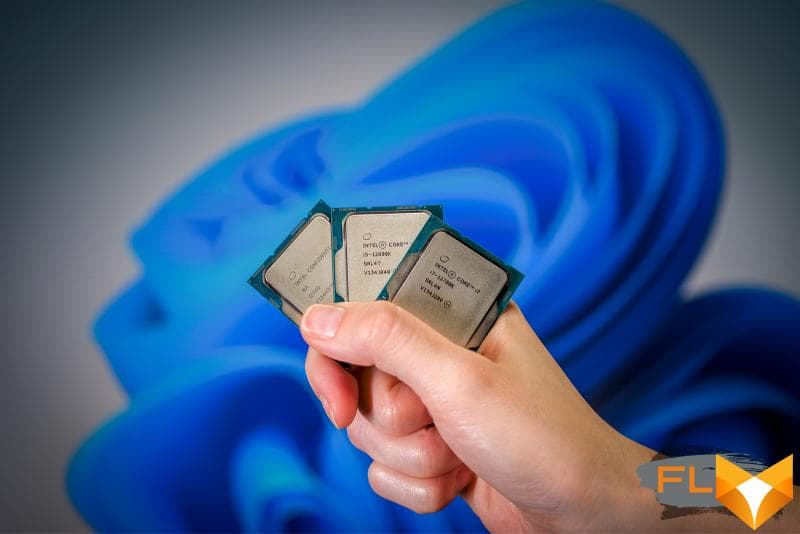
The most significant difficulty in the relationship between Alder Lake and Windows 10 could be an impressive list of games that have compatibility issues. But even here it can be argued that the transition to Windows 11 does not provide a solution in all cases. Moreover, Intel with partners from among the manufacturers of motherboards is preparing an effective “crutch” to bypass this problem in both the new and the old version of the OS.
Ultimately, the recommendation to use Windows 11 in PCs on Alder Lake processors can hardly be called unreasonable. However, it remains only a recommendation. If you don’t want to leave Windows 10 for some reason, you don’t have to upgrade to Windows 11 at all. Alder Lake is not the case when the processor imposes some harsh conditions on the software environment, it only gently pushes for the transition to a new version of the OS.

